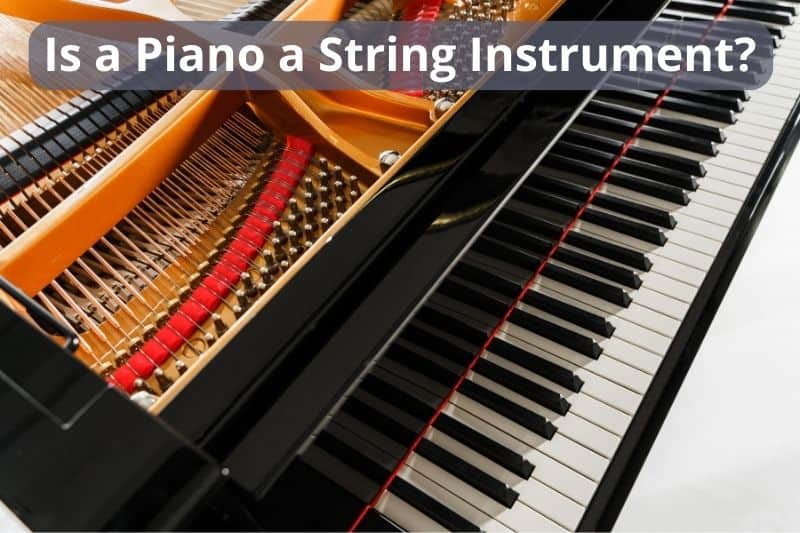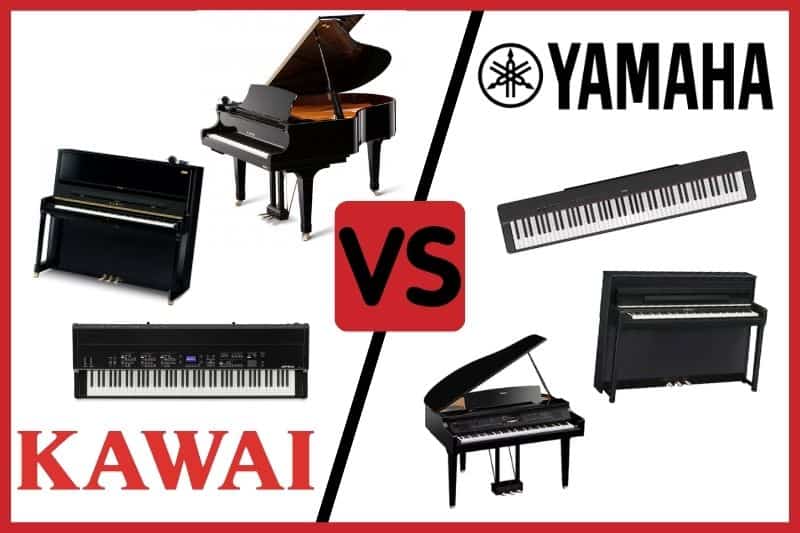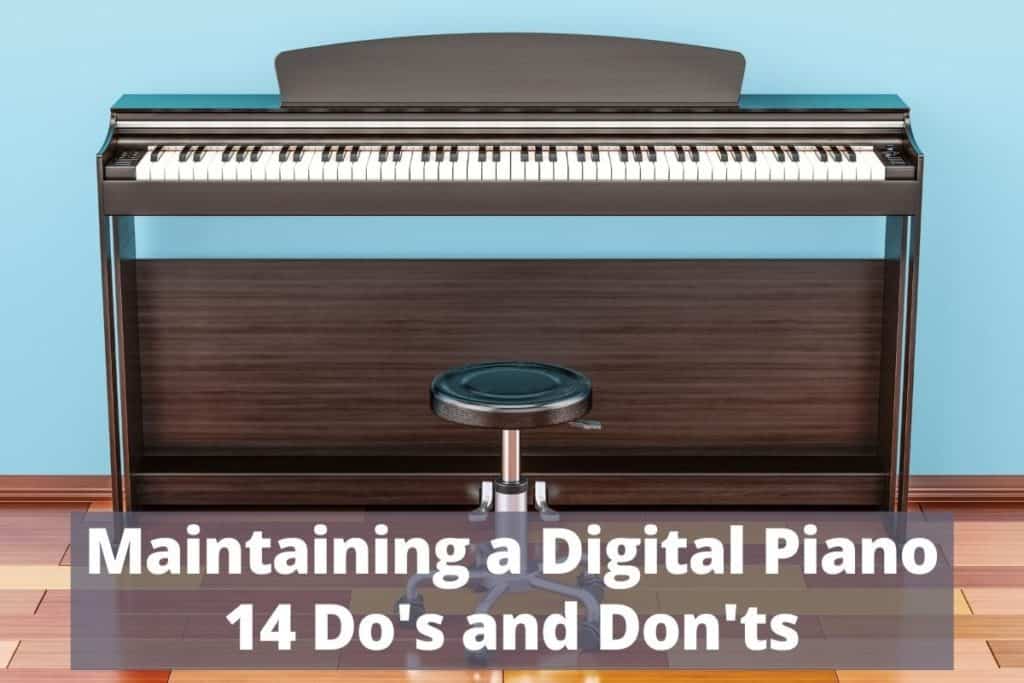
One of the biggest perks of purchasing a digital piano is the ease of use and maintenance. Although they are easier to maintain than a traditional acoustic one, there are still things that you can do to keep it in good condition and working well. Understanding what those differences are and keeping proper care of the piano will be crucial to its longevity and quality.
Digital pianos need to be cleaned and maintained just like any other musical instrument or piece of electronic equipment. Here are some great tips for looking after your digital piano:
| Do | Don’t |
| Wash and dry hands thoroughly before cleaning or playing piano | Use it as a shelf or lean on it |
| Read all manufacturer guidelines | Try to fix electronic problems yourself |
| Unplug piano when not in use | Set it near appliances that emit heat |
| Inspect outlets being used for piano | Overload an outlet to plug it in |
| Keep food and beverages away from piano | Allow it to sit in direct sunlight |
| Keep cords organized and out of the way | Allow pets to sit on the piano |
| Practice proper cleaning techniques | Keep it uncovered when it is not in use |
Any time you’re dealing with an instrument that has electronic components, your maintenance and cleaning procedures are already going to be different from that of an acoustic or non-digital instrument. These tips will help make sure your maintenance routine will do the job for your digital piano.
The Do’s of Digital Piano Maintenance
We are going to start by covering things you can do to show your digital piano some love and make sure it stays in excellent working condition. These can all be done quickly and easily without the need for a professional.
Wash and Dry Hands Thoroughly Before Cleaning or Playing Piano
As with any electronic device, you don’t want excess moisture seeping into it. If you don’t thoroughly dry your hands before using your piano in any way, you are risking having that water get in between the keys.
You should also be sure your hands are thoroughly clean when you begin to play, or before you play the piano. Sticky or dirty keys mean more frequent cleanings, and the best way to maintain any instrument or electronic device is to stay ahead of its cleaning needs.
Read all Manufacturer Guidelines
Every digital piano will come with their guidelines and instructions from the manufacturer. It’s easy to want to toss these to the side and forget all about them. It’s a piano, after all, just play it! Right?
Well, kind of.
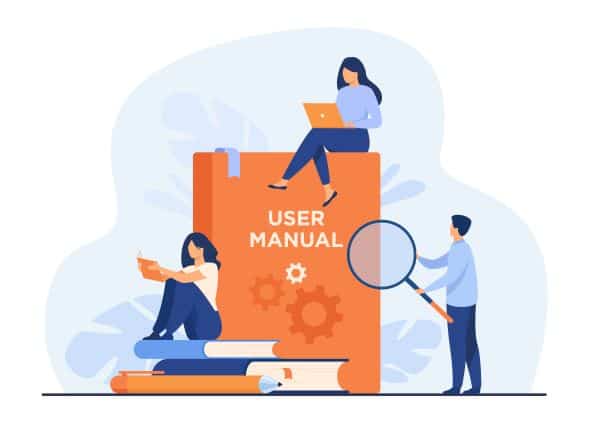
Those instructions will typically have some care guidelines included that can be extremely beneficial to keeping the piano in excellent working conditions for years to come. They should include best practices for different cleaning products and how to use them.
Not only should they include cleaning and care guidelines, but they will also include information from the manufacturer about warranty and repair issues.
If you think your digital piano needs repairing, then head to your instruction manual first. It will likely include some troubleshooting tips that you can try first. Unless you are a professional yourself, it is best to have someone more experienced help if none of the basic troubleshooting techniques are working.
Remember, if your piano is still under a manufacturer’s warranty, then if you start taking it apart, you may invalidate it.
Unplug Piano When Not in Use
The majority of digital pianos need an external power source for them to work and unplugging it can be a simple step to forget. You finish your session, and you’re onto something else. But unplugging it will help its longevity as well as being a good practice to have for any electronics to save electricity.
Be sure the piano is off before you unplug it. It can be harmful to the instrument if it is unplugged while still on, whether you are actively playing it or not.
Unplugging any type of electronic product when it’s not in use is smart. When a plug is in the outlet, even if the device is off, it still uses “phantom” or “vampire” electricity. The piano will continue to draw power from its source, even when it’s off.
Inspect Outlets the Piano Uses
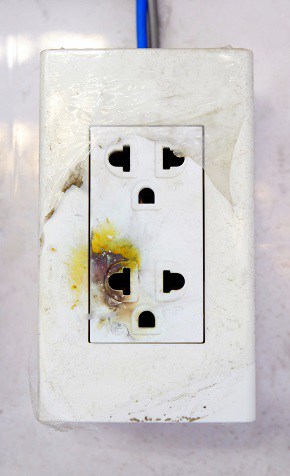
You always want to be sure the power socket you’re using is in good working condition. If you notice any debris or corrosion around the outlet, you should not plug your piano in there. This is also an excellent chance to look at the plug from the keyboard. Ensure the prongs are in good condition, and there is no corrosion or damage.
If something were to go wrong with the cord, outlet, or prongs, it would likely cause damage to the piano. This could be through something like an electrical surge or as severe as an electrical fire.
Keep Cords Organized and Out of the Way
Whether the piano is in use or not, the cords should always be hidden and organized. As we mentioned earlier, all components, including the cable, should be well maintained to avoid any electrical issues.
Cords that get tangled up with other wires or lie in the middle of a room are a safety hazard and can also cause damage to the piano if they are plugged in. Every time someone trips over that cord, there is the possibility of damage, either to the electronic components or the cable itself.
Keep Food and Beverages Away from the Piano
The first thing to mention when it comes to food or beverages around a digital piano is the warranty. Just about any electronic device you purchase will have a warranty. And that warranty will never cover any damage that was caused by a cup of coffee that seeped in through the keys and destroyed the entire circuitry beneath.

If liquid gets underneath the keys, it can cause lots of damage to the circuits and the many different electronic components that make up a digital piano. TechJunkie offers some great tips and resources when dealing with liquid spills on electronics. However, if your repair requires you to take the keyboard apart, and you still have that manufacturer’s warranty, chances are you will invalidate that cover by doing so.
Practice Proper Cleaning Techniques
Your first step to proper cleaning should come from reading the instruction manual. Make sure you adhere to all rules and guidelines they offer, specifically for your piano.
If you’ve lost the manual or are looking for some general tips, here are some great rules to abide by:
- Ensure the piano is off and unplugged.
- A quick dusting before cleaning will always help remove some of the loose dust and smaller particles.
- Purchase a mini vac to clean in between the keys. This is a great way to clear out excess crumbs or debris that has fallen in.
- Use a clean, soft cloth and avoid any other cleaning materials such as sponges, paper towels, or anything that may be too harsh.
- Use a cleaning solution that is geared towards electronics or specifically for digital pianos.
- Don’t go overboard on the solution. You don’t want the cloth dripping with liquids, but rather just have enough on it so it can help sweep away any dust or grime. It should be damp, but not wet.
- Have another clean, soft cloth ready to go. Once you wipe away any dirt and dust, use the dry cloth to wipe away the additional moisture.
- If you notice any stains or build-ups that you are unable to clean, it is wise to reach out to a professional technician who can help.
How to Know if You Have a Motherboard Issue
Before we get to the “Don’ts”, it’s essential to understand when your digital piano may be experiencing circuit issues. The circuitry inside these instruments can be complicated, and it is best to find professional technicians to repair these issues. Still, you can take the first step by trying to diagnose the problem.
If your piano is experiencing issues related to sound or the display, it will typically be a more straightforward fix. It could be as simple as swapping out keys or identifying a damaged speaker for sound issues. Or a light that is malfunctioning or screen issues on the LCD.
But if the unit is having issues turning on and is unable to get power, it can be a more complicated issue having to do with the Circuit Board, aka Motherboard. However, it’s worth reading this article with 14 reasons why your keyboard won’t turn on before you take any action.
Spoiler Alert: Fixing these issues yourself is tricky, so we’ll be covering your options more in this next section.
The Don’ts of Digital Piano Maintenance
Now that we covered a bunch of great tips that will help you keep your digital piano in great shape, we also need to talk about the things that you should steer clear of. While you are proactive by doing things like regular cleanings, you can also ensure these things aren’t happening to avoid future issues.
Use it as a Shelf or Lean on It
It can be tempting to use your piano as an additional shelf for pictures or odds and ends. It may look cute, but it won’t end up sounding cute if you continuously put too much weight on it.
Digital pianos were not built to hold things. They were also not made to hold you or act as a seat. Leaning on it from time to time can also be tempting, the same way you would lean against a table or small bookshelf. But doing this repeatedly can cause stress on the structure and lead to quality issues.
Overload an Outlet to Plug it In
Don’t allow the piano to be plugged into an outlet that is already full of other appliances. You should always try to have it plugged directly into a wall outlet rather than any type of extension cord or power strip.
Always consider the other things that are plugged in around it. If you must plug it into a power strip or extension cord, just be sure there are no other large or power-hungry appliances also sharing the cable.
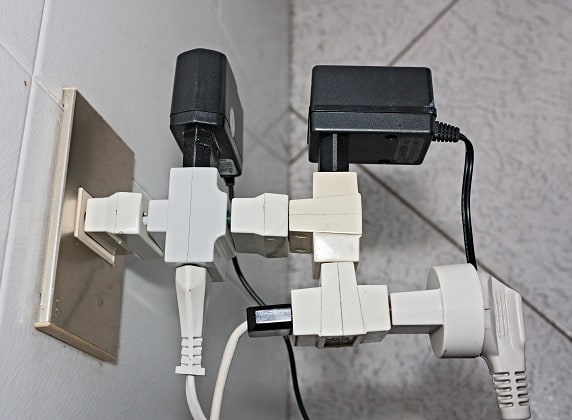
The key is not to have an overload of electricity trying to flow through there. Doing so may end up causing electronic damage to the piano at some point, and it can also be a fire hazard for your home.
Try to Fix Electronic Problems Yourself
Unless you are a certified technician, trying to fix electronic problems is not going to be a good move. Digital pianos are highly complex, and one problem can easily lead to another if not appropriately handled.
If you have any circuit or chip issues, then it’s best to get professional help!
Taking it to a musical instrument shop will be your best bet to start. They will be able to identify the problem, assess, and let you know if they will be able to fix it in house or not.
Set it Near Appliances That Emit Heat
Allowing your digital piano to be around too much heat can be detrimental to its quality. Of course, keeping it away from appliances like a stove would be wise. But there are still plenty of other devices that emit heat.
Computers and other electronics that heat up are often overlooked. The heat may not seem like a lot, but if it is placed right next to the computer, it can build up over time and become a less than desirable atmosphere for the digital piano.
Allow it to Sit in Direct Sunlight
Sitting in the sunshine, stroking the keys of your digital piano sounds like a perfect and relaxing afternoon. But the keyboard shouldn’t be kept in direct sunlight for long periods. However, the occasional stint in the sunshine should be fine.
Over time, the sun can easily weaken the plastic and cause additional wear and tear on the piano much sooner than expected. A large proportion of digital pianos are made from plastic, so this can significantly weaken the entire instrument.
If the piano is in direct sunlight, then it will most likely be near a window or door, and neither of these are ideal places for a keyboard. Windows not only let in that sunlight, but when open, they allow lots of dust into the room and, by extension, on the piano. Doors pose similar risks, but with the added danger of the door or the person entering knocking into the piano.
Allow Pets to Sit on it

It would be a lie to say that sleeping puppies or kitties on top of pianos aren’t the cutest things ever. As much as we’d love to allow our little furry family members to take a snooze or play on the keyboard and giggle in glee over the cuteness – it’s simply not a good idea.
Pet fur and hair can easily get lodged in between keys or worse, reach the circuits and cause damage there. It may not be something you see right away, but over time there can easily be a build-up of fur that will affect the quality and lifespan of the piano.
Aside from the fur, their paws can easily scratch and cause damage to the keys and other surfaces. So, unfortunately, it will be smart to let your beloved furballs sit to the side of the piano instead of on top of it. Placing their favorite bed beside it is a great way to encourage them to stay off the goods.
Keep it Uncovered When it is Not in Use
It’s nice to have a piano out in the open when you aren’t playing it. Aside from providing beautiful music, it can also offer an artful focal point. But if you want to keep it playing trouble-free for years to come, it would be best to keep it covered up when it is not being played.
If it comes with a keyboard cover built-in, then make sure it always gets closed when you’re finished playing. It is also wise to purchase a separate cover for it. The cover will help keep dust away, but many covers are also waterproof as extra insurance if the “No beverages near the piano” rule is not followed, and there is a spill.
Do Digital Pianos Need Servicing?
One frequently asked question is if digital pianos need servicing like traditional pianos. Acoustic pianos need regular servicing and tuning to help maintain the integrity of the strings and internal components. This, in turn, helps to preserve the lifespan of the piano as well as keep it properly tuned.
Servicing a traditional piano will be a separate necessity outside of tuning. But the process of servicing will, in turn, help keep your piano in tune for longer. Servicing a piano is a very time-consuming process as they are working on maintaining a multitude of small components.
Since a digital piano does not have the same inner workings as their acoustic counterparts, they do not require servicing the same way. By maintaining the digital piano properly throughout the year and following the steps we laid out in this article, you are essentially servicing the piano every day.
Digital pianos will never go out of tune because they do not have strings and all the other components, but rather just a recorded sample that is stored on an internal hard drive.
Maintaining Your Digital Piano Properly
While you may not need the same attention to detail and care that a traditional piano requires, your digital piano still needs proper maintenance and extra lovin’ from time to time to keep it in good order. It is good practice to make sure your keyboard stays clean, away from heat sources, and in a functional area of the home away from any potential hazards to get the best from it.

